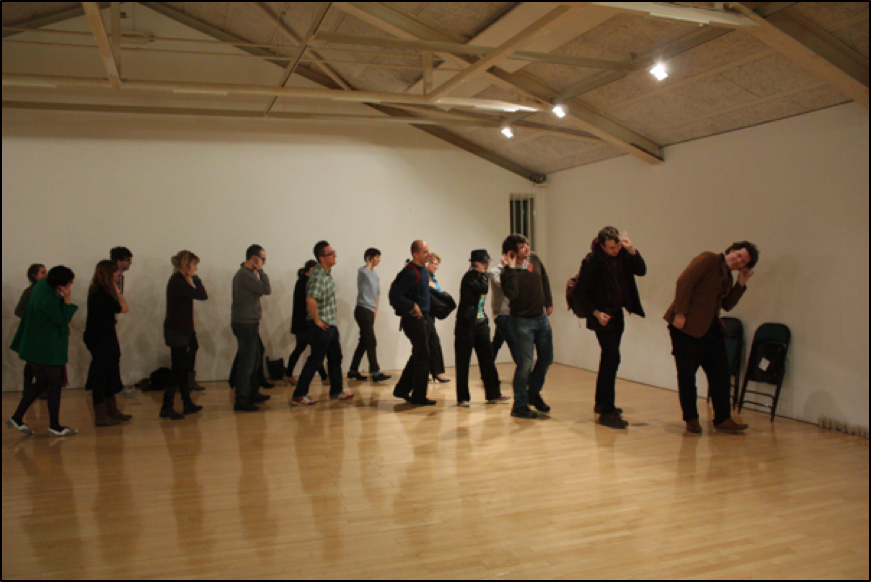
Dr Lee Campbell, lecturer in Academic Support across Camberwell, Chelsea and Wimbledon Colleges of Art, University of the Arts London
This article contributes to the field of critical performative pedagogy by presenting an example project which conceived performance as pedagogy. It considers interruptions to performance experiences as an immediate call for reflection (Savin-Baden, 2007) and ultimately, a ‘critical thinking tool’ (Meller, 2017). By employing a writing strategy that echoes a reflective model for undertaking practice-as-research designed by the author, entitled Anticipation, Action, Analysis, the article provides a framework in which to situate a discursive description of how interruption as a form of rupture or ‘disturbance’ (Vale, 2017) complicates the implicit contract between student and tutor in terms of the exchange of power in the relationship.
contract; interruption; performative pedagogy; power relations; reflective practice; risk-taking
This article examines student-tutor power relations by considering interruption. As an explicit form of disruption/disturbance, it asks whether performative interruptions offer a means of exposing and analysing the mechanisms of power at play between students and tutors. This analysis develops practice-as-research undertaken as part of my doctoral degree between 2010 and 2016, which explored Nicolas Bourriaud’s conception of participation and democracy in Relational Aesthetics (1998) in which he outlines a curatorial model refers to practices that emerge from a socially engaged artistic practice. This model critiques power relations in terms of the implicit ‘contractual arrangement’ (O’Dell, 1998) between a protagonist and the audience of a performance. The aim of this earlier research was not to alleviate social imbalances of power in participative performance, nor to reinstate them, but to draw attention to them and use this practice as a vehicle through which to initiate discussion of how social power (Foucault, 1980) operates in all aspects of our lives. The PhD research aimed to generate a new, or deepened, critical awareness of power and its uses and abuses in ordinary life.
Examining the perceived “contracts” governing the roles inhabited by student and tutors, this article reflects upon how performative interruption may be used as an effective tool for making exchanges of power visible in pedagogic settings. It refers to a peer observed seminar entitled ‘Performance and Collaboration’, delivered to a group of single honours, first year undergraduate Fine Art students at Loughborough University (hereafter referred to as LU) in March 2015. This seminar has had subsequent iterations. Audience participation is not conceived here in terms of a group of participants; instead the audience is considered as an assembly of bodies and exchanges.
As Michel Foucault asserts, performances are permeated by intricate sets of power relations that are intrinsically connected to the body (1980). This is accentuated by the fact that each body has a subjective experience, a shared commonality despite each person’s varied interpretations. Each audience member has a body that can be controlled and managed. In this way, the power relations of a performance are made visible through instructions to participants and how the actions of their bodies are choreographed into a piece.
Foucault suggests that power is achieved through techniques of bodily control, or biopower, which enact power through the subjugation of the body. As he writes, ‘there is nothing more material, physical and corporeal than the exercise of power’ (1980, pp.58-59). Further to this, Foucault’s neologism ‘governmentality’ refers to the enactment of power over people by government, describing how political power manages to regulate the population (Burchell, Gordon & Miller, 1991). There are parallels between state power and participative performance, where the State is the performer and the Subject is the audience. Power is ‘tolerable only on condition that it mask a substantial part of itself. Its success is proportional to its ability to hide its own mechanisms’ (Foucault, 1980, p.56).
Performance is a means of planning a situation where power relations can be explored. Power relations are made visible through the physical actions of the bodies of participant audiences, including those who attended performances made during my PhD. This earlier research into ‘the effects of power [in] shaping and misshaping the pedagogical act’ (Kincheloe, 2008, p.3) is re-framed to consider how power relations operate in relation to the implicit ‘contract’ between student and tutor. For example, my performance Lost for Words (produced at South Hill Park, Bracknell, 2011) was a lesson in how to influence others, to force them to do what you want them to do. As the protagonist, I used a mixture of convivial hospitality and coercive impoliteness to generate an embodied participative performance that employed slapstick to provoke a direct, bodily form of audience participation.
In my previous performances where I had attempted to convert audience members into co-performers, I would never say in a convivial manner, “Hello, how do you do? Fancy taking part in a performance? Would you like some time while you make up your mind?”. You would more likely hear me say, “Hello, now do it!”. Although I accept I do need a certain amount of conviviality to get audience members to do what I want during my performances, this time I needed to be far more assertive in my manner and instructions. At one point in the performance, I ordered audience members to form a line behind either my sidekick or myself. This was achieved by pointing to them and shouting, “You’re with me! You’re with him!” Examining the relationship between what is heard and what is seen, the audience undertook a march circling the performance space repeatedly. As participants began the march, they shouted the word “Yes” repeatedly as they shook their heads repeatedly. They would then say the word “No” whilst nodding their heads. Further actions consisted of setting up more “opposites”, where what the marchers would say would not correspond with the physical action being enacted through their bodies.
As we marched around the gallery performing slapstick using our bodies (figure 1), I thought to myself, “Bloody hell! They are all doing it. Everybody is doing the slapstick.” Nobody said no to my instruction. Maybe nobody wanted to kick up a fuss, appear the odd one out, or maybe they were all curious to find out what was going to happen. I couldn’t believe that I had been so rude and still managed to engage everybody. If audience members had not have been so obliging, I am sure that I would have been hurled an inflammatory remark when I turned to the audience and said, “Right you lot, your turn!”

The audience became.
…detectives of new theoretical insights, perpetually searching for new and interconnected ways of understanding power and oppression and the ways they shape everyday life and human experience.
(Kincheloe, 2008, p.49)
Performances act as a tool that make power relations visible through the choreography of (other) bodies, mirroring the power-plays that take place in all forms of daily human existence. This points to the ‘larger relevance of critical pedagogy involving its capacity to expose [make visible] life’s permanent conditions of oppression and exploitation’ (Kincheloe, 2008, p.86).
In Kathy O’Dell’s appraisals of ‘masochistic’ Performance Art from the 1970s, she suggests participation between performer and audience can be viewed as modelled upon ‘tacit or specified terms of a contract’ (1998, p.2). She refers to contractual arrangements underpinning all social relations; ‘everyday agreements - or contracts - that we all make with others but that may not be in our own interests’ (1998, p.2). Josette Féral and Ronald P. Bermingham combine the terms ‘tacit’ and ‘contract’ to suggest ‘the tacit contract between spectator and theater’ (2002, p.104), which is similar to expectations in art. The audience is either expecting, delighted with expectations exceeded, or disturbed with expectations broken.
The term ‘contract’ has been employed as a performative trope by many artists and performance makers. Beyond literature that considers a contract as document that sets out legal rights for artists and other parties, artists have used this format and its associations in their practice. In Contract with a Heckler (2013), a collaborative performance-based artwork by myself and Claire Makhlouf Carter, we envisioned artistic collaboration as a form of contract using a physical written contract (between a speaker and a heckler), to condition the nature of collaborative exchange in a performative lecture about heckling using heckling (Campbell, 2014). A reminder of how we constantly operate under invisible contracts, Contract with a Heckler ruptured the contract (between speaker and audience), triggering a performative artwork with relation to Claire Bishop’s call for more antagonism (Bishop, 2006).
Artists associated with historical art movements from the early twentieth century, such as Dadaism and Futurism often employed disruptive tactics to shock audiences, such as gluing audience members to seats and selling the same ticket to more than one person. They created planned yet spontaneous interruptions to the audiences’ experience and expectations. Such interruptions, disruptions and disturbances have the power to produce new knowledge, new taxonomies and revised thinking.
In performance-oriented education, as Michael Vale, Course Leader on the MA Theatre Design at Wimbledon College of Arts (UAL) suggests, positive ‘disturbances’ to the learning experience are generated by one’s own body of knowledge being subjected to a process involving ‘external – internal – external’ experiences (Vale, 2017). Bodies of knowledge that are externalised (already out in the world) become internalised (via student engagement through reading and other skills to understand this knowledge), and then made external again through the various methods or artistic practices that students choose to demonstrate their understanding.
The seminar ‘Performance and Collaboration’, sought to develop critical awareness of power relations as the means to achieve three aims. The first aimed to develop aspects of practice discussed in my doctoral thesis related to the focused usage of interruptive processes in contemporary art practice (Arlander, 2009). The second aim sought to provide students with direct experience of how interruption may command immediate reaction and force collaborative means of working (i.e. collective survival tactics to deal with interruption). Lastly, the seminar aimed to theorise, articulate and demonstrate how interruption relates to critical reflection (on the part of both student and teacher). These extend the ideas of Maggi Savin-Baden (2007) by proposing interruption as reflection. The seminar employed bricolage methods (Kincheloe, 2008) involving performance and fine art, directly engaging in a range of activities common to their daily life experiences, such as digital technologies.
The seminar adopted a model devised during my PhD research: moving through ‘Anticipation, Action and Analysis’. It started with a discussion ‘anticipating’ events that would take place as part of a forthcoming practical activity; the activity then took place as live ‘action’; which was then ‘analysed’ and reflected upon. This model is both a means of documenting the events of a seminar in written form and a structuring device to facilitate reflective practice in action, encouraging students to consider moments of planned and spontaneous interruption. This structure/approach facilitates student learning and reflects upon the experience of the tutor.
The aim of the seminar was to build upon students’ theoretical and practical understanding of collaboration as a core issue relating to Fine Art practice. It combined performance, art and collaborative methodologies in one activity to create something new by thinking across boundaries and crossing them. This practice would help students gain a sophisticated understanding regarding what may constitute the protocols of collaboration, how to encourage potential collaborations and embrace differences and similarities. It required them to think through the following questions: ‘What are the problems of collaborative practice?’ and ‘How can the problems (associated with collaboration) be creative?’. Assessment of how students got to grips with the intended learning outcomes tests this via statement and response, examining the students’ discussion of ‘collaboration’ in both theory and practice.
Aligned to a view of the classroom as a ‘venue for the construction of knowledge, not merely for its inculcation’ (Kincheloe, 2008, p.88) my pedagogic strategy for the seminar positioned it as a space of liminality (part-laboratory/part-discussion arena), so that students could move theories beyond abstraction towards physical/emotional/practical tangibility, thus allowing them to connect theory with practice. The nature of the practical activity planned for the seminar involved students engaging in interruptive processes. When researching this approach to employing interruption in performative pedagogy, I conducted interviews with other tutors at the University of the Arts London (UAL). These discussions offered broader insights into this pedagogy beyond my own practice. One such participant, Alex Schady, Fine Art Programme Leader at Central Saint Martins, explained his fascination with the ‘power structures inherent in a teaching situation’ (Schady, 2016). He has generated performative situations to make power relations ‘apparent and potentially abused’ (ibid):
I think what you have to do is make [the power relation in pedagogic processes] visible. Through making it visible, you don’t level the playing field but you make everyone aware of where they are in that playing field. And so, I’ve made a series of works [taking place in academic settings] that work with that – some of them are more about disruption than others.
(Schady, 2016)
Schady made specific reference to his use of interruption during a lecture at Chelsea College of Arts, teaching Fine Art and innovative forms of pedagogy. At regular intervals during the lecture a number would flash on the screen behind him. The number would correspond to an envelope that was amongst someone in the audience – the audience knew that if the number flashed they were invited to open that envelope and inside would be a command that gave that person permission to interrupt the lecture. Schady went on to state.
And so, some of them [the interruptions] were fairly mild, like just saying ‘boo’ and others involved coming up and drawing a moustache and glasses on my face. Others involved throwing a glass of water in my face. [Interruption] used to affirm that they [power dynamics] are there […] I do think that by pointing it [this power dynamic] out, there’s the hope that they [the students] might challenge it or they might try and invert it. It would be much richer for the students to try and challenge that power dynamic […] They become politicised, that can be very fruitful – if difficult to manages [laughs.
(Schady, 2016).
At the start of the seminar, I informed students that as part of ongoing Continuing Professional Development that I was engaged in at the time, the session would be observed by one of my colleagues.
Students began to build a rich critical vocabulary related to collaboration, using analogue media (Post-it notes, pen and paper). This was then translated digitally using various apps (figure 2).
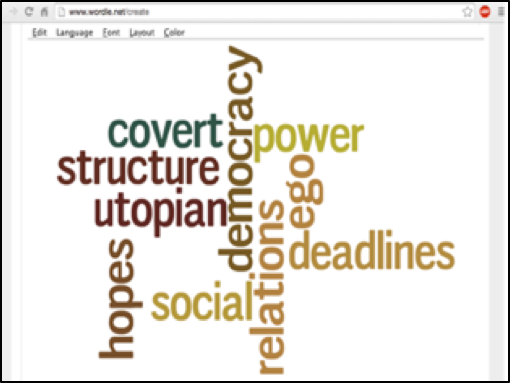
This was followed by students engaging directly in collaborative processes via performative activity. Students were split into two groups: Group A and Group B. Group B acted as ‘interruption-making bricoleurs’ (Figure 3), disrupting the other group’s (Group A) creative response to their set of instructions (Figure 4).

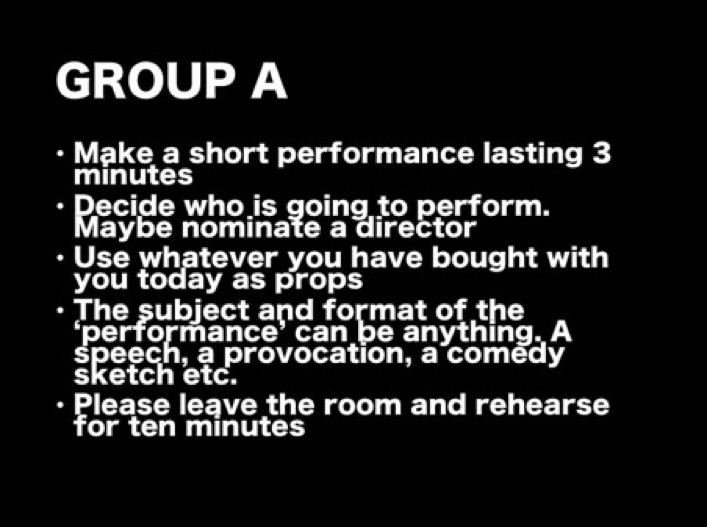
As interruption-makers students replicated aspects of a collaborative artwork produced as part of my doctoral study, Contract with a Heckler (2013). It inserted the heckler as both method and object into art performance as a way of reassessing the potential of interruption in democratic exchange, explored in relation to contemporary theories of art and participation.
By setting up this activity, the aim was not to find out how interruption could be effectively used within a pedagogic context such as in the classroom. I was intrigued to find out what combat strategies or ‘survival tactics’ the students would use (as a group collaboratively or individually) to deal with being faced with interruption (Hound, 2011). Students could then apply this experience directly, in terms of analysing selected examples of contemporary performance practice that contain interruptive processes, a topic to be covered in a subsequent seminar. One of the interruption-makers stripped off to his underpants whilst another picked up her bag, put on her coat and left the room without explanation, returning twenty minutes later. In the seminar, students then used their experience of generating group and individual performative interruptions to build a further critical vocabulary around the term ‘collaboration’ and to identify emergent concepts including ‘audience’ and ‘participation’ (Figures 5 and 6).
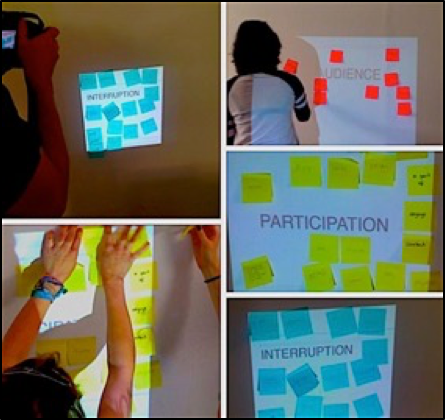
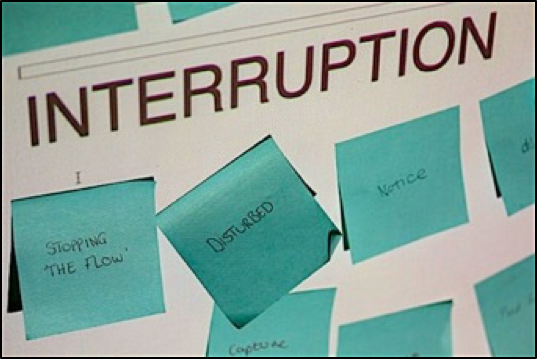
During a reflective feedback discussion session held towards the end of the seminar, including student engagement with the digital app Textwall (Figure 7), students commented upon what they saw as the benefits of the varying interruptions.
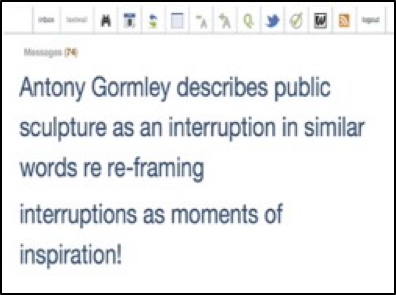
For many of the Group A students the interruptions by Group B helped them to think on their feet, be spontaneous and improvise. Many students commented that the time when one of the students left the room without explanation was an important moment during the seminar because for them this event was a disruptive intervention leading to a critical incident that embodied the power of interruption. Students observed that the session had helped them to further understand the key concepts relating to the seminar topic, resulting from the Performance-related methods, which helped them understand ‘collaboration’ in practice. Many of them started to use performance as a major component of their Fine Art practice.
Students told me they enjoyed listening to my description of the use of a physical written contract in making collaborative work, part of my recollection of Contract with a Heckler – after they had enacted the heckling activity. They commented that the stifling formality of the contract – getting everything in writing and being told what to do and when to do it – really helped them to think about some of the uncomfortable and other implicit power relations of collaborative work. The contract helped to make explicit those power relations.
Interruption accentuates ‘liveness’, which is an important concept for students of art and performance to understand. Teaching and learning is a live process and the teacher needs to be on full alert, ready with tactics such as ‘improvisation’ to deal with the serendipitous nature of this two-way process between teacher and learner. This situation shares similarities with the improvisation used in stand-up comedy, in the same way, students like to physically attend class in live real-time to see how the performer/teacher improvises. This is in addition to the benefits of learning as part of a group in a shared physical space, and the affective possibilities of ‘live’ unmediated teaching.
The serendipitous nature of working with the chaos of liveness involves techniques that use a mixture of improvisation and intuition as methodological survival-tactics. The danger that liveness can engender is half the excitement of teaching and of being a performance artist. As Chapman and Race observe, ‘coping with the unexpected is an important part of successful teaching’ (2009, p.20). The performance of interruption is an explicit form of liveness that raises many important questions and points to create a politics of surprise. By considering the student experience during the teaching seminar, students encountered the nature of liveness, albeit in a somewhat artificially constructed setting.
In their appraisal of the session, the peer observer commented that ‘a vibrant and rich learning experience for students’ was achieved and that ‘peer and experiential learning was strongly evident’ (Ingham, 2015). In terms of my own development as a teacher, the session taught me a great deal about some of the complexities involved when encouraging students to engage in performative pedagogic processes. It demonstrated the successes (and some of the dangers) of working with interruption; the session forced me to reflect upon issues around inclusion (generating an inclusive learning environment that includes performance).
This teaching session demanded that students be self-assured in using performance and specifically interruption as a performative technique. I expected students to be confident in using performance and demonstrate their personal feelings with relative ease. The student who left the seminar later revealed that she felt confident using the technique of interruption, but I was unsure whether she had left due to feeling uncomfortable with the activities taking place, or whether it was her response to the interruption task.
Issues of inclusivity aside, through her exiting, the student generated the perfect interruption, in so far that her actions entirely embodied art’s capacity for disruption. Whilst the peer observer made no mention of this student’s actions in her appraisal of the session – she did however take issue with the student who decided to strip off to his underpants. She stated: ‘some students may be particularly immature’ (Ingham, 2015), and suggested that in future, clear supportive guidelines should be set at the start of activities, for students to develop sound attitudes and professional behaviour in terms of the inclusive nature of learning collaboration. Some students may have felt uncomfortable about being ‘noticed’, whilst others deliberately tried to make themselves appear the centre of attention, no matter how far they breached codes of responsibility within the classroom. The objective in this teaching activity is to positively advance students’ existing knowledge-base, being careful not to dilute the power of interruptive processes, particularly if these form a major component of the pedagogic strategy. It is important to check with students that they are aware of the specific requirements of a task, underlining to them the importance of responsibility and appropriate interactions with others. Simultaneously, one must be careful not to stifle students whose creative works are specifically concerned with defining and redefining the limits and boundaries of ethical responsibility, between performer/artist and their respective audience.
Whilst some students in a group may be unafraid of expressing an opinion, others are less comfortable in doing so. The inclusivity of and initial guidance for any performance-related activity at the start of a teaching session is key to creating a safe space in which all students can actively engage in experimentation and risk-taking in their practice, in ways that do not discomfort or upset them.
Interruption is an effective form of performative pedagogy more suited to subjects involving a greater level of critical thinking and collaboration, such as the performance art seminar described in this article. Art and performance are all about disruption; they are both forms of dissent, dismantling and deconstruction. Parallels can be drawn between Dieter Roelstraete’s (2012) insistence that art has the capacity for disruption, the staged interruption taking place during my performance, Contract with a Heckler, and subsequent usage of interruptive processes in the art classroom. Performance Art and Art more broadly, is predicated on rule-breaking and discomforting audiences. It could be argued that interruptive processes are more suited to teaching situations relating to art and performance, as their potentially disruptive nature helps communicate the disruptive potential of art/performance. This contrasts with the teaching of other subjects such as English language, where disruption is not a prerequisite for learning how to be fluent and accurate in English.
The situation with the student stripping off to his underpants calls into question the relationship between art and its capacity for disruption as a form of creative expression and the boundaries of ethical responsibility on the part of both teacher and student. This prompts important questions concerning subjectivity, values and where one places one’s ethical compass when teaching.
Whilst presenting a guest lecture on strategies of digital pedagogy at the Leeds Institute for Teaching Excellence (University of Leeds) in November 2017, Dr Raphael Hallett asked me whether I am frustrated by ‘conventional criteria’ that emphasise the importance of ‘focus, precision, clarity, coherence, structure’ in teaching, continuing to observe that we often:
…value people’s work in terms of that very circumscribed, clean, clear presentation but many of the things [you have] been talking about, disruption, intervention, liminalities [etc.] are forms of expression that [do not] necessarily correspond with [conventional criteria], even collaboration and participation themselves [do not] lend themselves to coherence – how do you deal with that in terms of marking/assessing.
(Hallett in Campbell, 2017a).
Creative risk-taking, and the types of disruption that Hallett is alluding to, reiterate the creative ‘messiness’ surrounding and calling into question issues of ethical responsibility, freedom of speech and censorship in learning environments. On reflection, when considering the instance when a student walked out of the classroom, rather than worrying about how the students made me look in front of the teaching observer, I should have seen their actions as an embodiment of the provocative forms of Performance Art about which they were learning, an opportunity to discuss the ethical entanglements of the work. However, at the time, I was unsure of the student’s motivation for leaving and this uncertainty surrounding a student leaving the classroom was a concern, as it would be for any tutor, whether they are being observed by a peer or not.
Examining interruption and exploiting its virtues through practice exposes productive insights into the exchange of power. Interruptions remind us of the implicit structures of power relations and the processes at work in social communication. Despite teaching activities during my seminar consisting of seemingly light-hearted, staged interruptions, the most disruptive interruption was unplanned by me. The student’s exit provokes important questions not only in terms of what we constitute an interruption to be. An interruption is not really a disruption when it is planned. This calls for a reconsideration of ‘surprise’ tactics in the classroom. Pre-warning students about the possible contents of a teaching session would potentially undermine interruption, particularly if disruption informs the structure of the delivery of a teaching session. Forewarning students may also potentially effect the facilitation of creativity by limiting opportunities for experimentation.
Arlander, A. (2009) ‘Event scores for performing interruptions’, in Mäntymäki, T. and Mäkinen, O. (eds.) Art and Resistance. Vaasa: University of Vaasa, pp.153-168.
Billing, J., Lind, M. and Nilsson, L. (2007) Taking the matter into common hands: On contemporary art and collaborative practices. London: Black Dog.
Bishop, C. (2006) Participation. London: Whitechapel/MIT Press.
Bourriaud, N. (1998) Relational Aesthetics. Translated by David Macey. Dijon: Les Presses du Reel.
Burchell et al. (1991) The Foucault effect: Studies in governmentality. London: Harvester Wheatsheaf.
Campbell, L. (2017a) WATCH: LITE Masterclass: Technoparticipation – Digital Realia. Possibilities for Practice and Pedagogy, Leeds Institute for Teaching Excellence, University of Leeds, 22 November. Available at: http://teachingexcellence.leeds.ac.uk/events/lite-masterclass-technoparticipation-digital-realia-possibilities-for-practice-and-pedagogy/ (Accessed: 8 August 2018).
Campbell, L. (2017b) ‘You don’t need eyes to see, you need vision: Visual impairment, performative pedagogy and technology’, Journal of Pedagogic Development, 7(3), pp.3-12. Available at: https://journals.beds.ac.uk/ojs/index.php/jpd/article/view/397/594 (Accessed: 7 August 2018).
Campbell, L. (2014) ‘Heckler, performance, participation and politeness: Using performance art as a tool to explore the liminal space between art and theatre and its capacity for confrontation’, in Remes, O., Leino, M. and MacCulloch, L. (eds.) Performativity in the gallery: Staging interactive encounters. Oxford: Peter Lang Ltd, pp.137-156.
Chapman, F. and Race, P. (2009) Using peer observation to enhance teaching: A compendium. Leeds: Leeds Met Press.
Feral, J. and Bermingham, R. P. (2002) ‘Theatricality: The specificity of theatrical language’, in Substance: A Review of Theory and Literary Criticism, 31(2/3), Issue 98/99, pp.94-108. https://www.doi.org/10.2307/3685480.
Foucault, M. (1980) Power/knowledge: Selected interviews and other writings,1972–1977. Harvester Press: Brighton.
Hound, R. (2011) Stand-up put-downs. London: Bantam Press.
Ingham (2015) Email to Lee Campbell, 16 May.
Kincheloe, J. L. (2008) Critical pedagogy primer. New York: Peter Lang.
Meller, F. (2017) ‘Performing teaching’, Provocative Pedagogies: Performative Teaching and Learning in the Arts conference, University of Lincoln, Lincoln, 14 October 2017.
O’ Dell, K. (1998) Contract with the skin: Masochism, performance art and the 1970s. Minnesota: University of Minnesota Press.
Roelstraete, D. (2012) ‘Responses to presentations’, Of Hospitality: A Symposium, University of Chicago Arts / Smart Museum of Contemporary Art, Chicago, 4-5 May. https://www.artandeducation.net/announcements/109430/of-hospitality-a-symposium (Accessed: 7 August 2018).
Savin-Baden, M. (2007) Learning spaces: Creating opportunities for knowledge creation in academic life. Maidenhead: Open University Press.
Schady, A. (2016) Interviewed by Lee Campbell, 27 October.
Vale, M. (2017) ‘An introduction to the process of theatre design', UAL Library and Support Services conference, Wimbledon College of Arts, University of the Arts London, 18 July.
Dr Lee Campbell is a Lecturer in Academic Support across Camberwell, Chelsea and Wimbledon colleges, UAL. His practice explores how meaning is constructed through politics of space, and how the politics of art are articulated through visual and verbal languages. Recent research publications include PARtake: The Journal of Performance as Research and the Journal of Pedagogic Development. He is currently working on an edited collection called I Leap into Action: Critical Performative Pedagogies in Art & Design Education. In 2017, he was awarded with a University of Lincoln Best Practice Award in Promoting Equality in recognition for his research into teaching and supporting those with a vision impairment.